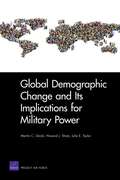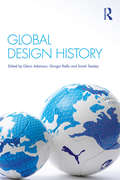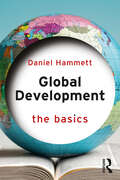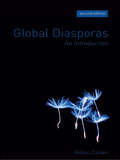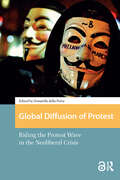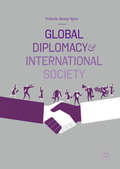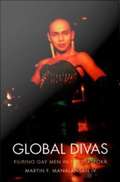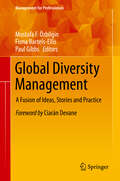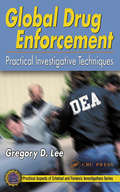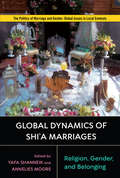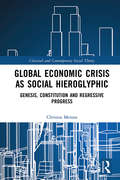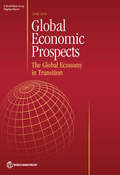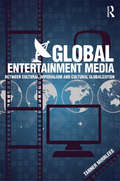- Table View
- List View
Global Democracy, Social Movements, And Feminism (Feminist Theory and Politics)
by Catherine EschleIn Global Democracy, Social Movements, and Feminism Catherine Eschle examines the relationship between social movements and democracy in social and political thought in the context of debates about the exclusions and mobilizations generated by gender hierarchies and the impact of globalization. Eschle considers a range of approaches in social and political thought, from long-standing liberal, republican, Marxist and anarchist traditions, through post-Marxist and post-modernist innovations and recent efforts to theorize democracy and social movements at a global level. The author turns to feminist theory and movement practices--and particularly to black and third world feminist interventions--in debates about the democratization of feminism itself. Eschle discusses the ways in which such debates are increasingly played out on a global scale as feminists grapple with the implication of globalization for movement organization. The author then concludes with a discussion of the relevance of these feminist debates for the theorization of democracy more generally in an era of global transformation.
Global Demographic Change and Its Implications for Military Power
by Martin C. Libicki Howard J. Shatz Julie E. TaylorWhat is the impact of demographics on the prospective production of military power and the causes of war? This monograph analyzes this issue by projecting working-age populations through 2050; assessing the influence of demographics on manpower, national income and expenditures, and human capital; and examining how changes in these factors may affect the ability of states to carry out military missions.
Global Design History
by Giorgio Riello Glenn Adamson Sarah TeasleyGlobalism is often discussed using abstract terms, such as ‘networks’ or ‘flows’ and usually in relation to recent history. Global Design History moves us past this limited view of globalism, broadening our sense of this key term in history and theory. Individual chapters focus our attention on objects, and the stories they can tell us about cultural interactions on a global scale. They place these concrete things into contexts, such as trade, empire, mediation, and various forms of design practice. Among the varied topics included are: the global underpinnings of Renaissance material culture the trade of Indian cottons in the eighteenth-century the Japanese tea ceremony as a case of ‘import substitution’ German design in the context of empire handcrafted modernist furniture in Turkey Australian fashions employing ‘ethnic’ motifs an experimental UK-Ghanaian design partnership Chinese social networking websites the international circulation of contemporary architects. Featuring work from leading design historians, each chapter is paired with a ‘response’, designed to expand the discussion and test the methodologies on offer. An extensive bibliography and resource guide will also aid further research, providing students with a user friendly model for approaches to global design. Global Design History will be useful for upper-level undergraduate and postgraduate students, academics and researchers in design history and art history, and related subjects such as anthropology, craft studies and cultural geography.
Global Development and Environment
by Joe Williams James DuminyAvailable open access digitally under CC-BY licence. Development and environmental challenges are often framed at the global or planetary scale, but in a vague or apolitical manner. This book develops a theoretically rigorous and politicized concept of the planetary to intervene in contemporary debates on global development and to enhance our critical understanding of development as we approach the second quarter of the twenty-first century. Chapters explore key themes and processes including urbanization, demographic change, health, financialization, and infrastructure development. Referencing diverse cases and examples drawn from across the world, the book argues that the futures of global development are inseparable from environmental challenges and transformations.
Global Development: The Basics (The Basics)
by Daniel HammettHow do we try to make the world a better place, when the challenges of poverty, disease, war, conflict, and climate change continue to impact millions of lives? Global Development: The Basics is a lively and engaging introduction to the shifting landscape of global development, right from its origins, to present-day problems, and on to what the future for global development might look like. Recognising global development as an economic, political, and social project, this book tackles a series of critical questions: asking ‘what’ development is and how it is measured, where and to whom it is assumed to happen, how its approaches are developed, and whose benefit do they serve? The book invites readers to consider the complexities and challenges of the concept of development, including its historical roots in colonialism, and the geopolitical power relations which continue to set much of the agenda. It investigates whose voices are included or silenced in dominant approaches to development, and the growing importance of ‘non-traditional’ development funding and approaches. Covering key topics in the field, from economics and politics, through to gender and climate change, Global Development: The Basics is perfect for readers starting out in their understanding of global development.
Global Diasporas: An Introduction
by Robin CohenFollowing its initial publication in 1997, Global Diasporas: An Introduction was central to the emergence of diaspora studies and quickly established itself as the leading textbook in the field. This expanded and fully-revised 25th anniversary edition adds two new chapters on incipient diasporas and diaspora engagement while carefully clarifying the changing meanings of the concept of diaspora and incorporating updated statistics and new interpretations seamlessly into the original text. The book has also been made more student-friendly with illustrations, thought-provoking questions, and guides to further reading. The book features insightful case studies and compares a wide range of diasporas, including Jewish, Armenian, African, Sikh, Chinese, British, Indian, Lebanese, Afghan and Caribbean peoples. This edition also retains Cohen’s rich historical and sociological descriptions and clear yet elegant writing, as well as his modified concept of ‘diasporic rope’ linking different features of diasporas. This updated edition of the definitive textbook in the field will be an indispensable guide for students and instructors seeking to explore the complex issues of diaspora, migration and identity.
Global Diasporas: An Introduction (Global Diasporas)
by Robin CohenAn introduction to the concept of diaspora which provides the basic building blocks of comparative and theoretical analysis. It explores the relationship between migration, homeland and identity for both traditionally recognized and newer diasporas.
Global Diffusion of Protest: Riding the Protest Wave in the Neoliberal Crisis (Protest and Social Movements)
by Donatella Della PortaRecent years have seen a new development in the growth and spread of popular protest: protests that began as local, homogeneous events-such as Occupy Wall Street or the protests of the Arab Spring-quickly left their original locations and local specificity behind and became global. This book looks at the development of this wave of protests, with an eye on protests against austerity and neoliberal economic policies, and offers a global view, covering events in Turkey, Brazil, Venezuela, South Africa, Bosnia, Bulgaria, Ukraine, and other locations.
Global Dimensions of Qualitative Inquiry (International Congress of Qualitative Inquiry Series #8)
by Norman K. Denzin Michael D. GiardinaThis focused collection of original articles addresses the global dynamics of qualitative inquiry and the contextual dimensions within which such inquiry takes place. Contributions from many of the world's leading qualitative researchers in communications, education, sociology, and related disciplines focus on the changing landscape of social media, human rights, the Global South, and decolonizing methodologies, and guide the field toward a more engaged, global perspective. Chapters were developed from plenary sessions of the Eighth International Congress of Qualitative Inquiry (2012).
Global Diplomacy and International Society
by Yolanda Kemp SpiesThis book is a comprehensive overview of the theory, history, law, institutional framework and culture of global diplomacy. It reflects on the key existential challenges to the institution and addresses aspects that are often overlooked in diplomatic studies: inter alia diplomatic law, development-driven diplomacy and the bureaucracy of diplomatic practice. All chapters are extensively illustrated with recent case examples from across the world. Special emphasis is placed on incorporating perspectives from Africa and other developing regions in the Global South, so as to balance the Eurocentrism of traditional diplomatic literature.
Global Divas: Filipino Gay Men in the Diaspora
by Martin F. Manalansan IVA vivid ethnography of the global and transnational dimensions of gay identity as lived by Filipino immigrants in New York City, Global Divas challenges beliefs about the progressive development of a gay world and the eventual assimilation of all queer folks into gay modernity. Insisting that gay identity is not teleological but fraught with fissures, Martin Manalansan IV describes how Filipino gay immigrants, like many queers of color, are creating alternative paths to queer modernity and citizenship. He makes a compelling argument for the significance of diaspora and immigration as sites for investigating the complexities of gender, race, and sexuality. Manalansan locates diasporic, transnational, and global dimensions of gay and other queer identities within a framework of quotidian struggles ranging from everyday domesticity to public engagements with racialized and gendered images to life-threatening situations involving AIDS. He reveals the gritty, mundane, and often contradictory deeds and utterances of Filipino gay men as key elements of queer globalization and transnationalism. Through careful and sensitive analysis of these men's lives and rituals, he demonstrates that transnational gay identity is not merely a consumable product or lifestyle, but rather a pivotal element in the multiple, shifting relationships that queer immigrants of color mobilize as they confront the tribulations of a changing world.
Global Diversity Management: A Fusion of Ideas, Stories and Practice (Management for Professionals)
by Mustafa F. Özbilgin Paul Gibbs Fiona Bartels-EllisThis book explores how global organisations and institutions manage Equality, Diversity and Inclusion (EDI) across their operations and within different cultural and value settings. It blends empirical evidence from collaborative research with original practical insights. In addition, the book demonstrates how the idea of narratives can be used as an approach to achieving EDI goals, presenting powerful stories on EDI implementation and challenges stemming from EDI-related abuses. Taken together, the book’s respective chapters depict the complexity of EDI in a nuanced way, reflecting the disparate realities of those involved in its implementation. The combination of academic research and insights from practitioners in the field give the book a unique position in the global management literature on EDI, while also yielding a wealth of valuable lessons and conclusions.
Global Domestic Workers: Intersectional Inequalities and Struggles for Rights
by Sabrina Marchetti Daniela Cherubini Giulia Garofalo GeymonatEPDF and EPUB available Open Access under CC-BY-NC licence. Drawing from the EU-funded DomEQUAL research project across 9 countries in Europe, South America and Asia, this comparative study explores the conditions of domestic workers around the world and the campaigns they are conducting to improve their labour rights. The book showcases how domestic workers’ movements put ‘intersectionality in action’ in representing the interest of various marginalized social groups from migrants and low-income groups to racialized and rural girls and women. Casting light on issues such as subjectification, and collective organizing on the part of a category of workers conventionally regarded as unorganizable, this ambitious volume will be invaluable for scholars, policy makers and activists alike.
Global Drug Enforcement: Practical Investigative Techniques (Practical Aspects Of Criminal And Forensic Investigations Ser.)
by Gregory D. LeeIt's a national epidemic and an international conspiracy. Drugs have infested our society with a vengeance, making the drug enforcement agent a central figure in the war on drugs. International training teams of the U.S. Drug Enforcement Administration (DEA) have traditionally taught the special skills required by all drug agents. Until now, there
Global Dynamics of Shi'a Marriages: Religion, Gender, and Belonging (Politics of Marriage and Gender: Global Issues in Local Contexts)
by Mary Elaine Hegland Yafa Shanneik Annelies Moors Anna-Maria Walter Jihan Safar Marianne Hafnor Bøe Eva Nisa Sophie Yvie Girard Tara AsgarilalehMuslim marriages have been the focus of considerable public debate in Europe and beyond, in Muslim-majority countries as well as in settings where Muslims are a minority. Most academic work has focused on how the majority Sunni Muslims conclude marriages. This volume, in contrast, focuses on Twelver Shi'a Muslims in Iran, Pakistan, Oman, Indonesia, Norway, and the Netherlands. The volume makes an original contribution to understanding the global dynamics of Shi'a marriage practices in a wide range of contexts--not only its geographical spread but also by providing a critical analysis of the socio-economic, religious, ethnic, and political discourses of each context. The book sheds light on new marriage forms presented through a bottom up approach focusing on the lived experiences of Shi'a Muslims negotiating a diverse range of relationships and forms of belonging.
Global Ecology in Historical Perspective: Monsoon Asia and Beyond
by William Balée Kazunobu IkeyaThis book primarily examines human-animal and human-plant interactions in Asian forests (Southeast Asia and Japan) and inland waters (China). For comparison, cases from the Americas (whales in the Arctic, sea turtles in the Caribbean, and plants in the Amazon) and Central Asia are also included. The relationship between plants, animals, and humans in Asia is quite unique from a global perspective. For example, "satoyama" in Japan means ecotone area, or the boundary between a village and a forest. There, as the number of inhabitants declines, bears, wild boars, and other animals increasingly ravage crops, sometimes attacking humans as well.By showing the regional nature of human-animal and human-plant interactions in Asia, this book provides for the first time a framework for understanding the world's animal and plant-human relationships. It is assumed that the relationships between humans and animals and plants during this period were diverse, including hunting, taming, semi-domestication, and full domestication. At the same time, for regions outside of Asia, the extent to which these diverse relationships were adapted and how diversity was formed is explained from the perspective of historical ecology.Customers can expect to derive perspectives on the coexistence of human-animal and plant-animal relationships from this book in the near future.The conservation of rare species, diverse habitats, and biodiversity is a central theme in considering the relationship between modern civilization and the global environment. In post-industrial Japan, one focus has been the protection of iconic animals such as storks, crested ibis, dugongs, and sea turtles, while damage to crops and humans by deer, wild boars, monkeys, bears, and other common animals has become an important social issue. How can the world's 7.7 billion-plus people live in harmony with other species? We would like to get some hints on how to solve the problems we are facing.
Global Ecology: Environmental Change and Social Flexibility
by Vaclav SmilThe magnitude and rapidity of global environmental change threatens the perpetuation of life on Earth. Many aspects of this crisis are familiar to us - the destruction of tropical rainforests, the hole in the Antarctic ozone, desertification, soil erosion - yet we avoid the underlying challenge of a rapidly deteriorating ecological system and the breadth and complexity of responses demanded. Integrating an analysis of both social and environmental needs, the book explores the premises and problems of different paths towards global management. With its emphasis on flexible response, Global Ecology furthers our understanding of biospheric change and of our abilities and weaknesses in managing the transition to a sustainable society.
Global Economic Crisis as Social Hieroglyphic: Genesis, Constitution and Regressive Progress (Classical and Contemporary Social Theory)
by Christos MemosThis book examines the 2008 global economic crisis as a complex social phenomenon or "social hieroglyphic", arguing that the crisis is not fundamentally economic, despite presenting itself as such. Instead, it is considered to be a symptom of a long-standing, multifaceted, and endemic crisis of capitalism which has effectively become permanent, leading contemporary capitalist societies into a state of social regression, manifest in new forms of barbarism. The author offers a qualitative understanding of the economic crisis as the perversion, or inversion, of the capitalistically organized social relations. The genesis of the current crisis is traced back to the unresolved world crisis surrounding the Great Depression in order to map the course and different "inverted forms" of the continuous global crisis of capitalism, and to reveal their inner connections as derivative of the same social constitution. From a historical and interdisciplinary perspective, the book expounds critical social theory, elaborating on the intersection between the early critical theory of the Frankfurt School – mainly Adorno, Horkheimer, and Marcuse – and the "social form" analysis of the Open Marxism school. Global Economic Crisis as Social Hieroglyphic critically addresses the permanent character of the 1920s–1930s crisis and the "crisis theory" debates; the political crisis in Eastern Europe (1953–1968); the crisis of Keynesianism; the crisis of subversive reason; the crisis, negative anthropology and transformations of the bourgeois individual; the state of social regression and the destructive tendencies after the rise of neoliberalism; and finally, the 2008 financial crisis and its ongoing aftermath.
Global Economic Prospects, June 2015: The Global Economy in Transition
by The World BankGlobal growth is expected to be 2.8 percent in 2015, but is expected to pick up to 3.2 percent in 2016-17. Growth in developing countries and some high-income countries is set to disappoint again this year. The prospect of rising borrowing costs will compound the challenges many developing countries are facing as they adapt to an era of low commodity prices. Risks to this outlook remain tilted to the downside. This edition of Global Economic Prospects includes two Special Features that analyze the policy challenges raised by the two transitions in developing countries: the risks associated with the first U.S. central bank interest rate increase since 2006 and the implications of persistently low commodity prices for low-income countries. Global Economic Prospects is a World Bank Group Flagship Report that examines global economic developments and prospects, with a special focus on developing countries, on a semiannual basis (in January and June). The January edition includes in-depth analyses of topical policy challenges faced by developing countries while the June edition contains shorter analytical pieces.
Global Economic and Cultural Transformation
by Mohamed RabieSociety today faces multi-dimensional challenges that are hard to define and even harder to deal with. Social and economic systems throughout the world are becoming more complex and interdependent, and globalization is moving beyond the sphere of economics to engulf other aspects of life, particularly culture and security. Our current theories, strategies, and road maps are fast becoming out-dated and no new ones have emerged to take their place. Mohamed Rabie re-examines the relevance of major ideas and systems of the recent past, including ideology and its relation to society in Global Economic and Cultural Transformation. This book is an attempt defines and explains this transitional period and provides a new conception of economic and societal world history, which us understand how we got here and where we are going.
Global Elite Migrations: Agency and Networks of Migrant-Artists from the Former Soviet Bloc (IMISCOE Research Series)
by Irina IsaakyanThis open access book explores the lives and careers of migrating artists with the purpose to understand how they make use of their migrant-networks and how this process interacts with decisions they make about immigration and career development. Situated at the crossroads of Migration Studies and Elite Studies, this interdisciplinary research is based on sixty interpretive biographic interviews with opera singers from the former Soviet bloc who work in various places across Europe and beyond. The book raises the question to what extent they exercise agency as migrants and professionals and to what extent they preserve their professional elitism on the transnational level. The case of these migrant-artists serves to illuminate the dynamics of a wider phenomenon - global elite migrations - which is compared with an intergalactic journey. Through this sociological metaphor, the book offers a new analytical framework to think about the “agency-network” nexus.
Global Entangled Inequalities: Conceptual Debates and Evidence from Latin America (Entangled Inequalities: Exploring Global Asymmetries)
by Renata Motta Elizabeth Jelin Sérgio CostaThis book presents studies from across Latin America to take up the challenge of exploring the plurality of social inequalities from a global perspective. Accordingly, it identifies the structural forces of social inequalities on a world scale as they shape asymmetries observed in a wide array of phenomena, such as racial and gender inequality, urbanization, migration, commodity production, indigenous mobilization, ecological conflicts, and the "new middle class". A rich contribution to the study of the interconnections between the global social structure and multiple local and national hierarchies, Global Entangled Inequalities brings consistently together a variety of conceptual approaches, ranging from ethnographies to legal genealogies, and will therefore appeal to scholars across the social sciences with interests in social theory, power analysis, intersectionality studies, urban studies, and global social and environmental justice.
Global Entanglements of a Man Who Never Traveled: A Seventeenth-Century Chinese Christian and His Conflicted Worlds (Columbia Studies in International and Global History)
by Dominic SachsenmaierBorn into a low-level literati family in the port city of Ningbo, the seventeenth-century Chinese Christian convert Zhu Zongyuan likely never left his home province. Yet Zhu nonetheless led a remarkably globally connected life. His relations with the outside world, ranging from scholarly activities to involvement with globalizing Catholicism, put him in contact with a complex and contradictory set of foreign and domestic forces. In Global Entanglements of a Man Who Never Traveled, Dominic Sachsenmaier explores the mid-seventeenth-century world and the worldwide flows of ideas through the lens of Zhu‘s life, combining the local, regional, and global. Taking particular aspects of Zhu‘s multiple belongings as a starting point, Sachsenmaier analyzes the contexts that framed his worlds as he balanced a local life and his border-crossing faith. At the local level, the book pays attention to the intellectual, political, and social environments of late Ming and early Qing society, including Confucian learning and the Manchu conquest, questioning the role of ethnic and religious identities. At the global level, it considers how individuals like Zhu were situated within the history of organizations and power structures such as the Catholic Church and early modern empires amid larger transformations and encounters. A strikingly original work, this book is a major contribution to East Asian, transnational, and global history, with important implications for historical approaches and methodologies.
Global Entertainment Media: A Critical Introduction
by Lee ArtzBalancing provocative criticism with clear explanations of complex ideas, this student-friendly introduction investigates the crucial role global entertainment media has played in the emergence of transitional capitalism. Examines the influence of global entertainment media on the emergence of transnational capitalism, providing a framework for explaining and understanding world culture as part of changing class relations and media practices Uses action adventure movies to demonstrate the complex relationship between international media political economy, entertainment content, global culture, and cultural hegemony Draws on examples of public and community media in Venezuela and Latin America to illustrate the relations between government policies, media structures, public access to media, and media content Engagingly written with crisp and controversial commentary to both inform and entertain readers Includes student-friendly features such as fully-integrated call out boxes with definitions of terms and concepts, and lists and summaries of transnational entertainment media
Global Entertainment Media: Between Cultural Imperialism and Cultural Globalization
by Tanner MirrleesA critical cultural materialist introduction to the study of global entertainment media. In Global Entertainment Media, Tanner Mirrlees undertakes an analysis of the ownership, production, distribution, marketing, exhibition and consumption of global films and television shows, with an eye to political economy and cultural studies. Among other topics, Mirrlees examines: Paradigms of global entertainment media such as cultural imperialism and cultural globalization. The business of entertainment media: the structure of capitalist culture/creative industries (financers, producers, distributors and exhibitors) and trends in the global political economy of entertainment media. The "governance" of global entertainment media: state and inter-state media and cultural policies and regulations that govern the production, distribution and exhibition of entertainment media and enable or impede its cross-border flow. The new international division of cultural labor (NICL): the cross-border production of entertainment by cultural workers in asymmetrically interdependent media capitals, and economic and cultural concerns surrounding runaway productions and co-productions. The economic motivations and textual design features of globally popular entertainment forms such as blockbuster event films, TV formats, glocalized lifestyle brands and synergistic media. The cross-cultural reception and effects of TV shows and films. The World Wide Web, digitization and convergence culture.

